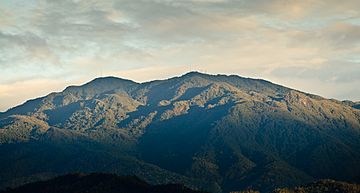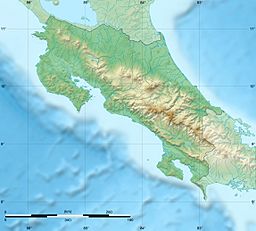Cerro de la Muerte facts for kids
Quick facts for kids Cerro de la Muerte |
|
|---|---|

Cerro de la Muerte from the city of San Isidro
|
|
| Highest point | |
| Elevation | 3,451 m (11,322 ft) |
| Geography | |
| Parent range | Cordillera de Talamanca |
| Climbing | |
| Easiest route | road |
Cerro de la Muerte is a tall mountain peak in Costa Rica. It is part of a large group of mountains called a massif. This mountain is found inside the Tapantí — Cerro de la Muerte Massif National Park. It is also the highest point you will reach on the famous Pan-American Highway.
Contents
Why is it Called "Mountain of Death"?
The name "Cerro de la Muerte" means "Mountain of Death" or "Hill of Death." This name comes from a long time ago. Back then, crossing these mountains from the Central Valley was very hard. It took three or four days, either walking or riding horses. Many travelers were not ready for the journey. They often got too cold or wet and sadly died.
Today, it is much easier to visit this mountain. The main road, Route 2, goes very close to it.
Exploring Cerro de la Muerte
You can reach a peak of Cerro de la Muerte by driving on a special track. This track starts near Kilometer 89 on the highway. At the top, you will see many towers for telecommunications.
There is also a short walking trail from the highway. This trail leads to another peak marked with a barrel. A sign on the highway shows its highest point. This spot is about 3,335 meters (10,942 feet) high.
At this high altitude, the nights can get very cold. Temperatures can even drop below freezing, sometimes colder than -6°C. But in the morning, the sun quickly warms things up. Be careful, though, because the air is thin and clear. This means you can get sunburned easily.
The Talamanca Mountains
Cerro de la Muerte is part of the Talamanca mountain range. This range stretches from eastern Costa Rica into western Panama. Long ago, this mountain range was an island made of volcanoes. Over time, the land was pushed up by tectonic uplift. Because it was separated from other mountains, many unique plants and animals grew here. Some of these species are similar to those found in the Andes mountains.
Plants and Animals
The highest parts of Cerro de la Muerte are a special type of habitat called páramo. Here, you will find small, bushy plants and dwarf bamboo. There are also tree ferns and smaller plants like blueberry, gooseberry, and lady's slipper.
Below the páramo, the natural forest is full of oak trees. These forests also have bamboo growing underneath them. This is a fantastic place to spot the amazing resplendent quetzal. This bird is famous for its bright colors and long tail feathers.
Almost half of the bird species found on Cerro de la Muerte live only in the Talamanca range. These special birds include the fiery-throated hummingbird and the timberline wren. You might also see the sooty robin, black-billed nightingale-thrush, peg-billed finch, and volcano junco.
Historical Resting Stops
Because crossing Cerro de la Muerte was so difficult, people needed places to rest. In the early 1900s, three special resting stations were created. This happened because of a law signed on August 5, 1908.
Between 1910 and 1912, these three resting stops were built. They were called "División," "La Muerte," and "Ojo de Agua." They were placed about 10 to 12 hours of hiking apart. Travelers had a rule to leave firewood ready for the next person who used the station.
In 1990, the government recognized how important these old resting houses were. Then, on November 20, 2016, the "Casa Refugio Ojo de Agua" was fixed up. It is now a small museum where you can learn about the history of crossing the mountain.
See also
 In Spanish: Cerro de la Muerte para niños
In Spanish: Cerro de la Muerte para niños
- Cerro de la Muerte Biological Station





